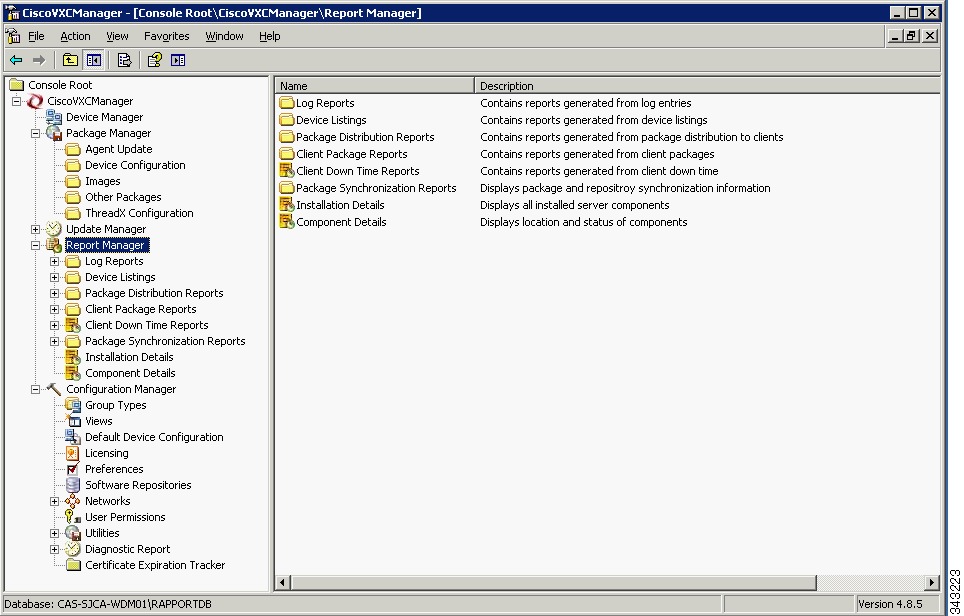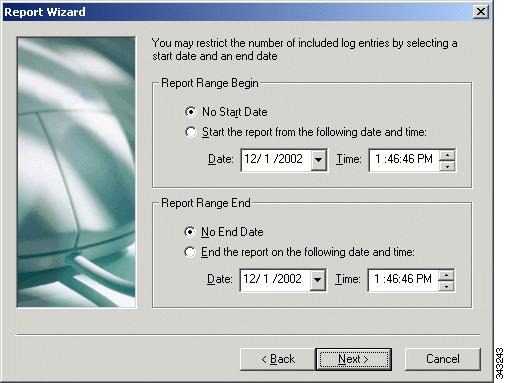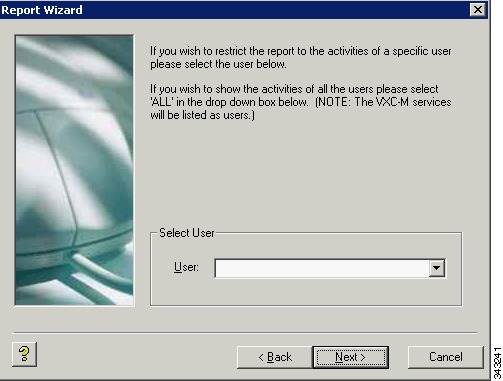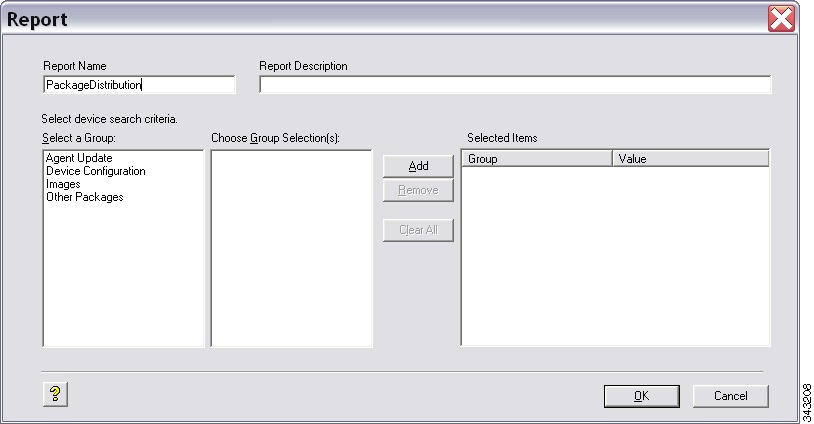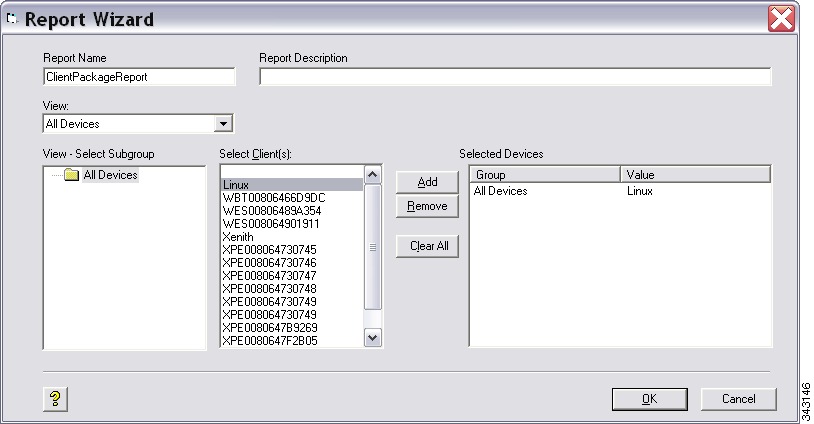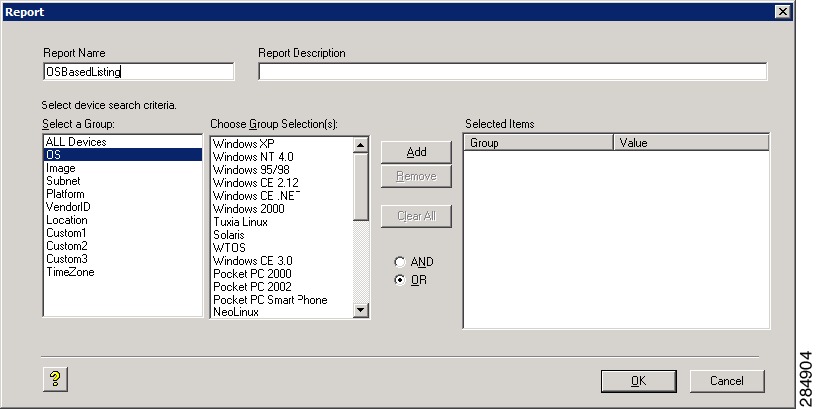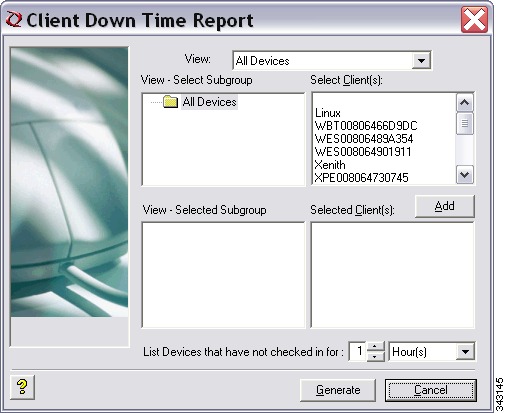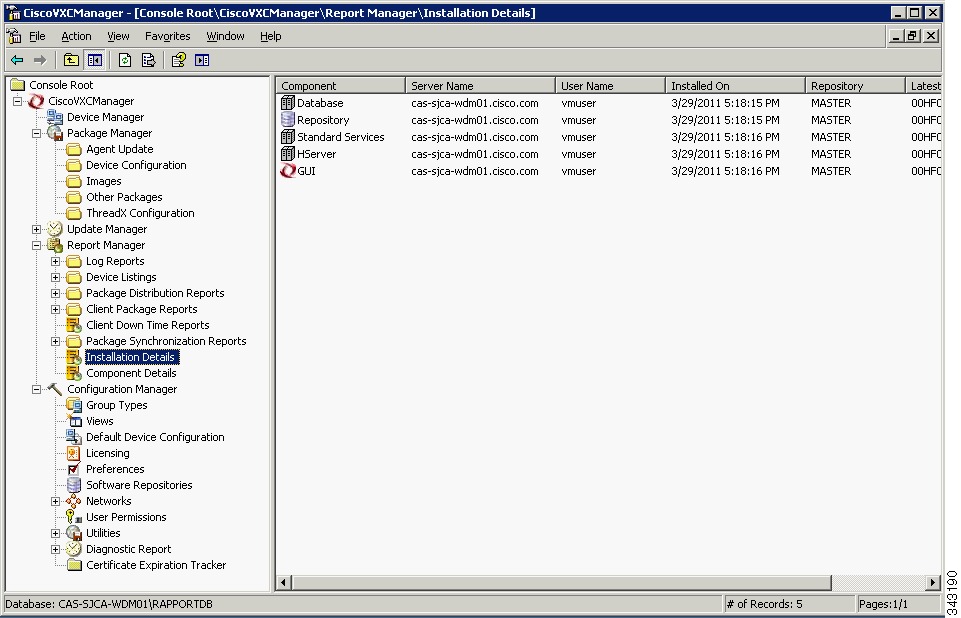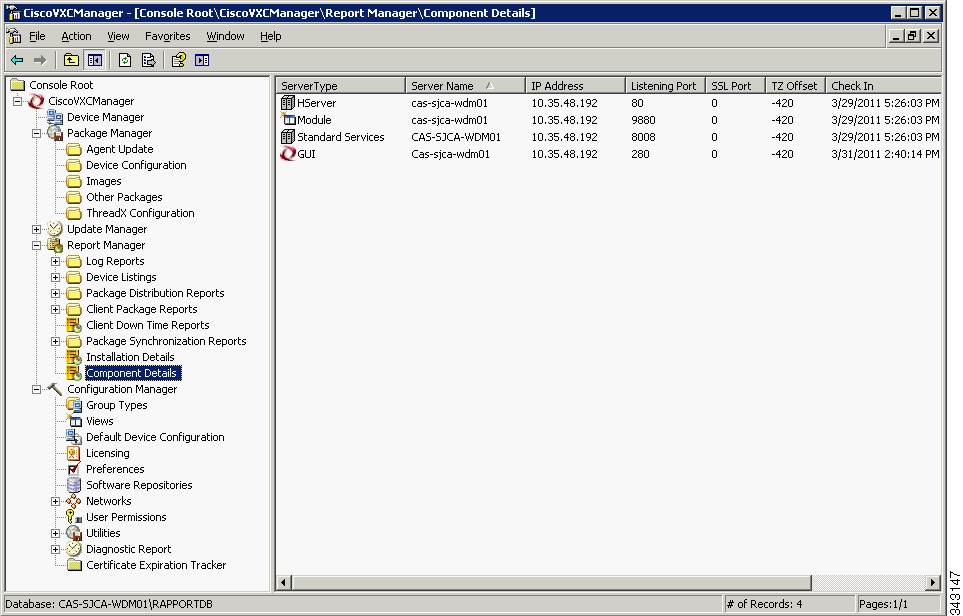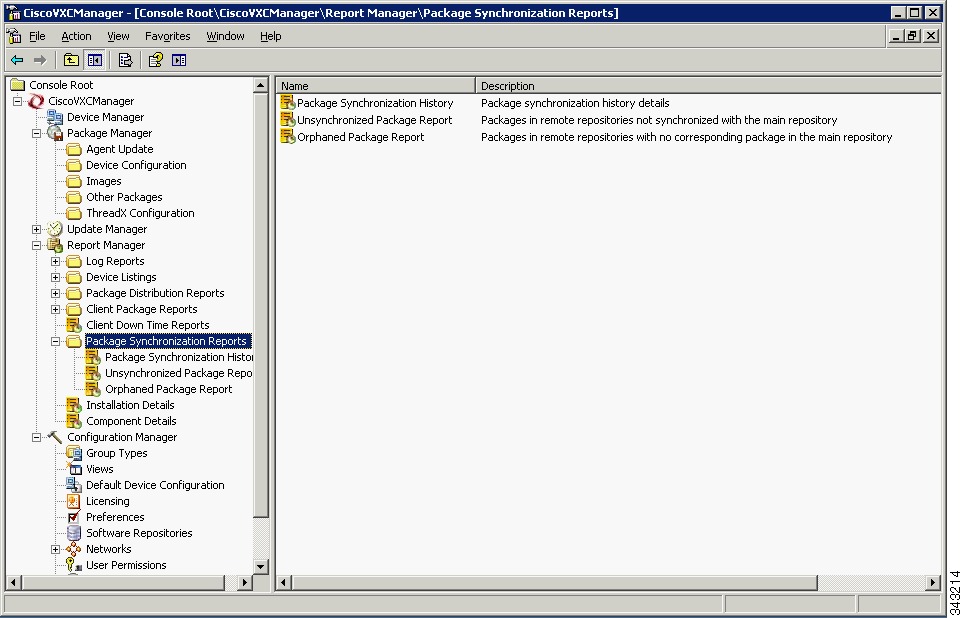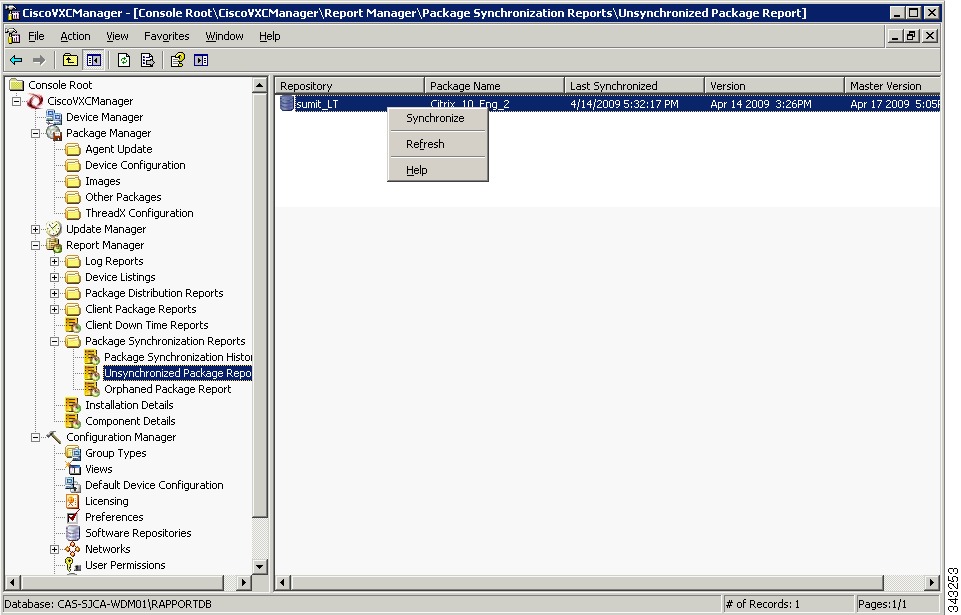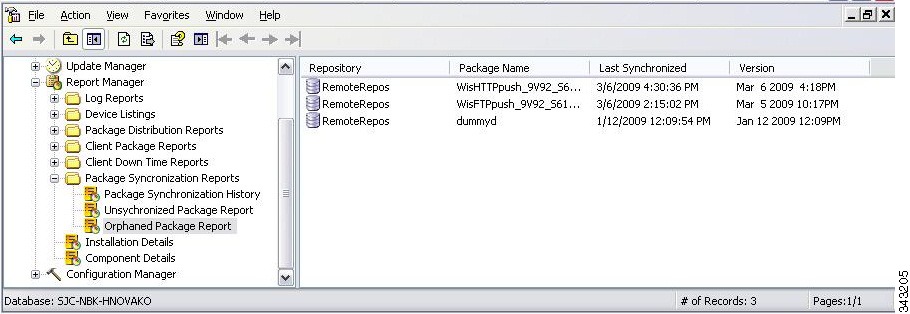

-
Administration Guide for Cisco Virtualization Experience Client Manager 4.9
-
Preface
-
Getting Started
-
Device Manager
-
Package Manager
-
Cisco VXC Firmware and Configuration Upgrade Procedures
-
Update Manager
-
Report Manager
-
Configuration Manager
-
Appendix A: Working with Groups and Views
-
Appendix B: About Cisco VXC Manager Security
-
Appendix C: Upgrading Cisco VXC Manager Agents
-
Appendix D: Device Discovery, Device Imaging, and Mass Imaging Tool
-
Appendix E: Troubleshooting
-
Appendix F: Licensing and Sales Keys
-
Appendix G: Additional Package Manager Procedures
-
Appendix H: Cisco VXC Manager ScriptBuilder Tool and Scripting Language
-
Appendix I: Autogenic Imaging
-
Table Of Contents
Package Synchronization Reports
Package Synchronization History Reports
Unsynchronized Packages Reports
Report Manager
This chapter describes how to create and manage Cisco VXC Manager reports using the Administrator Console. It provides information and instructions to help you generate various reports on your Cisco VXC Manager environment.
Creating and Managing Reports
Click Report Manager in the tree pane of the Cisco VXC Manager Administrator Console to open the Report Manager. The Report Manager allows you to quickly create and manage the reports available about your Cisco VXC Manager environment (see Table 6-1). It also allows you to easily display the current information from your devices according to the criteria you set in the report.
Figure 6-1 Report Manager
Tip
To choose the columns you want displayed within the details pane for a report, right-click the details pane containing the report and choose View > Add/Remove Columns to open and use the Add/Remove Columns dialog box.
To export a report to a .txt or .csv file, right-click the Report Manager folder you want (for example, Log Reports), choose Export List, and then use the Export to a File dialog box.Table 6-1 provides a quick overview of what you can do using the Report Manager.
Table 6-1 Routine Report Manager Tasks
Create a report listing activities related to all Cisco VXC Manager components according to your logging preferences (for example, all administrator activities within a start and end time).
In the tree pane of the Administrator Console, expand Report Manager, right-click Log Reports, and then choose New > Report to open and use the Report Wizard.
To set your logging preferences, see Logging Preferences.
Create a report listing managed devices according to your criteria (for example, all devices according to operating system).
In the tree pane of the Administrator Console, expand Report Manager, right-click Device Listings, and then choose New > Report to open and use the Report Wizard.
Create a report with information about managed devices according to the Cisco VXC Manager packages you have distributed (for example, all devices according to a specific Cisco VXC Manager package update).
In the tree pane of the Administrator Console, expand Report Manager, right-click Package Distribution Reports, and then choose New > Report to open and use the Report Wizard.
Create a report with information about the Cisco VXC Manager packages you have distributed according to the devices in your Cisco VXC Manager environment (for example, all Cisco VXC Manager package updates according to a specific Cisco VXC Manager device).
In the tree pane of the Administrator Console, expand Report Manager, right-click Client Package Reports, and then choose New > Report to open and use the Report Wizard.
Create a report with information about the software installed on the devices in your Cisco VXC Manager environment according to your criteria (for example, software according to subnet).
In the tree pane of the Administrator Console, expand Report Manager, right-click Installed Software Reports, and then choose New > Report to open and use the Report Wizard.
Create a Client Down Time report to view information about the down-time period for specific devices in your Cisco VXC Manager environment.
In the tree pane of the Administrator Console, expand Report Manager, right-click Client Down Time Reports, and then choose New > Report to open and use the Report Wizard.
Display an Installation Details report to view information about the installed components of Cisco VXC Manager.
In the tree pane of the Administrator Console, expand Report Manager and choose Installation Details to view the report in the details pane.
Display a Component Details report to view information about the running components of Cisco VXC Manager.
In the tree pane of the Administrator Console, expand Report Manager and choose Component Details to view the report in the details pane.
Create a Package Synchronization History report to view the details of Cisco VXC Manager package synchronizations for each Cisco VXC Manager package in the Master Repository with a Remote Repository.
In the tree pane of the Administrator Console, expand Report Manager, expand Package Synchronization Reports, and then choose Package Synchronization History to view the report in the details pane.
Package Synchronization History Reports. See also Package Synchronization Reports.
Create an Unsynchronized Packages report to view the details of Cisco VXC Manager package synchronizations that have not taken place for Cisco VXC Manager packages in the Master Repository with a Remote Repository.
In the tree pane of the Administrator Console, expand Report Manager, expand Package Synchronization Reports, and then choose Unsynchronized Packages Report to view the report in the details pane.
Unsynchronized Packages Reports. See also Package Synchronization Reports.
Create an Orphaned Package report to view the details of Cisco VXC Manager packages that still remain in the Remote Repository while the related Cisco VXC Manager packages have been deleted in the Master Repository.
In the tree pane of the Administrator Console, expand Report Manager, expand Package Synchronization Reports, and then choose Orphaned Package Report to view the report in the details pane.
Orphaned Package Reports. See also Package Synchronization Reports.
Log Reports
Log Reports provide information about the activities related to all Cisco VXC Manager components according to your logging preferences (see Logging Preferences).
Tip
After you create a Log Report, Cisco VXC Manager automatically saves the criteria and there is no need to create that report again. Each time you view the report (click the report name in the appropriate folder) you see current information according to the criteria you set. You can also refresh a report by right-clicking the folder containing the report and selecting Refresh.
Procedure
Step 1
In the tree pane of the Administrator Console, expand Report Manager, right-click Log Reports and choose New > Report to open the Report Wizard.
Step 2
Enter a name and description for the report (so you can easily recognize it later) and click Next.
Figure 6-2 Start and End Options
Step 3
Set the start and end options you want, and then click Next.
Figure 6-3 Specify Users
Step 4
Choose the option you want from the User list, and then click Finish to create the report.
Device Listings
The Device Listings report provides information about the devices in your Cisco VXC Manager environment according to your grouping ("listing") criteria.
Tip
Once you create a Device Listings report, Cisco VXC Manager automatically saves the criteria and there is no need to create that report again. Each time you view the report (click the report name in the appropriate folder) you see current information according to the criteria you set. You can also refresh a report by right-clicking the folder containing the report and choosing Refresh.
Procedure
Step 1
In the tree pane of the Administrator Console, expand Report Manager, right-click Device Listings and choose New > Report to open the Report Wizard.
Step 2
Use the following guidelines when creating the report:
•
Enter a name and description for the report (so you can easily recognize it later).
•
Choose a Group you want in the Select a Group list to display the Group Selections available for that Group.
•
After selecting the item in the Group Selections list you want, you can add it (click Add) to the Selected Items pane using either the AND option or the OR option.
•
When adding more than one item in the Group Selections list from the same Group to the Selected Items pane, you must use the OR condition.
•
When selecting across different Groups, you can use only one selection condition, either AND or OR. For example, if you choose the OS and Subnet Groups, and the selection condition is AND, the report will list only the devices that meet both the OS and Subnet criteria. Conversely, if the selection condition for the same two Groups is OR, the report will list all devices that match the OS criteria (regardless of subnet) and all devices that match the Subnet criteria (regardless of OS).
•
The conditions AND and OR are global. After you apply the AND or OR condition to the first two selection Groups, that same condition applies to all other selections across other Groups you choose.
•
To remove an item from the Selected Items pane, choose the item and click Remove.
•
To remove all items from the Selected Items pane, click Clear All.
Step 3
After completing your criteria, click OK to create the report.
Package Distribution Reports
Package Distribution Reports provide information about managed devices according to the Cisco VXC Manager packages you have distributed.
Tip
Once you create a Package Distribution Report, Cisco VXC Manager automatically saves the criteria and there is no need to create that report again. Each time you view the report (click the report name in the appropriate folder) you see current information according to the criteria you set. You can also refresh a report by right-clicking the folder containing the report and choosing Refresh.
Procedure
Step 1
In the tree pane of the Administrator Console, expand Report Manager, right-click Package Distribution Reports and choose New > Report to open the Report Wizard.
Figure 6-4 Package Distribution Reports Criteria
Step 2
Use the following guidelines when you create the report:
•
Enter a name and description for the report (so you can easily recognize it later).
•
Choose a Group you want in the Select a Group list to display the Group Selections available for that Group.
•
After selecting the items in the Group Selections list you want, you can add them (click Add) to the Selected Items pane.
•
To remove an item from the Selected Items pane, choose the item (for example, Update5XPE) and click Remove.
•
To remove all items from the Selected Items pane, click Clear All.
Step 3
After completing your criteria, click OK to create the report.
Client Package Reports
Client Package Reports provide information about the Cisco VXC Manager packages you have distributed according to the devices in your Cisco VXC Manager environment.
Tip
Once you create a Client Package Report, Cisco VXC Manager automatically saves the criteria and there is no need to create that report again. Each time you view the report (click the report name in the appropriate folder) you see current information according to the criteria you set. You can also refresh a report by right-clicking the folder containing the report and choosing Refresh.
Procedure
Step 1
In the tree pane of the Administrator Console, expand Report Manager, right-click Client Package Reports and choose New > Report to open the Report Wizard.
Figure 6-5 Client Package Reports Criteria
Step 2
Use the following guidelines when creating the report:
•
Enter a name and description for the report (so you can easily recognize it later).
•
Choose a view that contains the devices you want in the View list (for information on creating a View, see Managing Views).
•
Choose a Subgroup that contains the devices you want in the View - Select Subgroup list to display the clients available for that subgroup.
•
After you choose the items in the Select Clients list, click Add to add them to the Selected Devices pane.
•
To remove an item from the Selected Devices pane, choose the item (for example, WES008) and click Remove.
•
To remove all items from the Selected Devices pane, click Clear All.
Step 3
After you complete your criteria, click OK to create the report.
Installed Software Reports
Installed Software Reports provide information about the software installed on the devices in your Cisco VXC Manager environment according to your criteria.
Tip
After you create an Installed Software report, Cisco VXC Manager automatically saves the criteria and you do not need to create that report again. Each time you view the report (click the report name in the appropriate folder) you see current information according to the criteria you set. You can also refresh a report by right-clicking the folder containing the report and selecting Refresh.
Step 1
In the tree pane of the Administrator Console, expand Report Manager, right-click Installed Software Reports and choose New > Report to open the Report Wizard.
Figure 6-6 Report Wizard
Step 2
Use the following guidelines when creating the report:
•
Enter a name and description for the report (so you can easily recognize it later).
•
Choose the software you want in the Select Software list to display the version available for that Software.
•
Choose the version you want in the Select Version list.
•
Depending on whether or not the software is already installed on the devices, choose Yes or No.
•
Choose a group you want in the Select a Group list to display the Group Selections available for that group.
•
After selecting the item in the Group Selections list you want, you can add it (click Add) to the Selected Items pane using either the AND option or the OR option.
•
When adding more than one item in the Group Selections list from the same group to the Selected Items pane, you must use the OR condition. For example, if you choose SUSE Linux and ThreadX from the OS group, you must use the OR condition (the report will display all devices that run any of the selected operating systems).
•
When selecting across different groups, you can use only one selection condition, either AND or OR. For example, if you choose the OS and Subnet groups, and the selection condition is AND, the report will list only the devices that meet both the OS and Subnet criteria. Conversely, if the selection condition for the same two groups is OR, the report will list all devices that match the OS criteria (regardless of subnet) and all devices that match the Subnet criteria (regardless of OS).
•
The conditions AND and OR are global. After you apply the AND or OR condition to the first two selected groups, that same condition applies to all other selections across other groups you choose.
•
To remove an item from the Selected Items pane, choose the item (for example, SUSE Linux) and click Remove.
•
To remove all items from the Selected Items pane, click Clear All.
Step 3
After completing your criteria, click OK to create the report.
Client Down Time Reports
Client Down Time Reports provide information about the downtime period for specific devices in your Cisco VXC Manager environment.
Procedure
Step 1
In the tree pane of the Administrator Console, expand Report Manager and click Client Down Time Reports.
Step 2
In the toolbar, click the Create A New Report icon
.
Figure 6-7 Client Down Time Reports Criteria
Step 3
Use the following guidelines when creating the report:
•
Choose a view that contains the devices you want in the View list (for information on creating a View, see Managing Views).
•
Choose a subgroup that contains the devices you want in the Select Subgroup list to display the Clients available for that Subgroup.
•
After selecting the items in the Select Clients list you want, you can add them (click Add) to the Selected Subgroups pane and Selected Clients pane.
•
Enter the time values you want in the List Devices That Have Not Checked In For fields.
Step 4
After completing your criteria, click Generate to create the report.
Installation Details Report
Installation Details reports provide information about the installed components of Cisco VXC Manager.
Procedure
Step 1
In the tree pane of the Administrator Console, expand Report Manager and choose Installation Details to view the report in the details pane.
Figure 6-8 Installation Details
Step 2
You can view:
•
Component—Name of Cisco VXC Manager component
•
Server Name—Name of the server in which the Cisco VXC Manager component is installed
•
User Name—Login ID of the User of the server
•
Installed On—The date and time when the Cisco VXC Manager component was installed
•
Repository—Name of the main Cisco VXC Manager repository
•
Latest Hot Fix ID—ID of the latest Cisco VXC Manager hotfix installed on the server
Component Details Report
Component Details reports provide information about the running components of Cisco VXC Manager.
Procedure
Step 1
In the tree pane of the Administrator Console, expand Report Manager and choose Component Details to view the report in the details pane.
Figure 6-9 Component Details
Step 2
You can view:
•
Server Type—Name of Cisco VXC Manager component
•
Server Name—Name of the server in which the Cisco VXC Manager component is installed
•
IP Address—IP Address of the server in which the Cisco VXC Manager component is installed
•
Listening Port—Port number where the specific component is communicating
•
SSL Port—SSL Port Number
•
TZ Offset—The value of the offset between the local time zone and GMT
•
Check In—The date and time when the specific component checked in
•
Check Out—The date and time when the specific component checked out
Package Synchronization Reports
Package Synchronization Reports provide information about the synchronization of Cisco VXC Manager packages between the Master Repository and Remote Repositories. There are three types of Package Synchronization Reports that you can view and export:
•
Package Synchronization History—Displays the synchronization details of all Cisco VXC Manager packages with a Remote Repository (see Package Synchronization History Reports).
•
Unsynchronized Package Report—Displays a row for each Cisco VXC Manager package for which the version is different between the Master Repository and Remote Repository (see Unsynchronized Packages Reports).
•
Orphaned Package Report—Displays the list of Cisco VXC Manager packages which are present in the Remote Repository but have no corresponding Cisco VXC Manager package in the Master Repository (see Orphaned Package Reports).
Figure 6-10 Package Synchronization Reports
Package Synchronization History Reports
Package Synchronization History reports display the details of Cisco VXC Manager package synchronizations for each Cisco VXC Manager package in the Master Repository with a Remote Repository. One row is displayed for each time a Cisco VXC Manager package is synchronized with a Remote Repository. A Cisco VXC Manager package synchronized with n Remote Repositories will display n rows each time that Cisco VXC Manager package is synchronized.
Procedure
Step 1
In the tree pane of the Administrator Console, expand Report Manager, expand Package Synchronization Reports, and then choose Package Synchronization History to view the report in the details pane.
Figure 6-11 Package Synchronization History
Step 2
One row is displayed for each time a Cisco VXC Manager package is synchronized between the Master Repository and a Remote Repository. The number of rows displayed for a specific a Cisco VXC Manager package equals the number of times that Cisco VXC Manager package has been synchronized. You can view:
•
Repository—Name of the Remote Repository for which the Cisco VXC Manager package was synchronized
•
Package Name—Name of the Cisco VXC Manager package
•
Synchronization Time—The time the Cisco VXC Manager package was synchronized with the Remote Repository. Note that the Cisco VXC Manager packages scheduled for synchronization (but not yet started) do not have a synchronization time displayed.
•
Version—Only valid for the most recent synchronization of that Cisco VXC Manager package
•
Master Version—Current version of the Cisco VXC Manager package in the Master Repository
•
Status—Comparison of the version of the Cisco VXC Manager package between the Master Repository and a Remote Repository at the current time as follows:
–
Synchronized—The Cisco VXC Manager packages are the same.
–
Not Synchronized—The Cisco VXC Manager packages are different.
–
Deleted—The Cisco VXC Manager package in the Master Repository has been deleted (if the related Cisco VXC Manager package still remains in the Remote Repository, you can view it in the Orphaned Package report as described in Orphaned Package Reports).
Unsynchronized Packages Reports
Unsynchronized Packages reports display the details of Cisco VXC Manager package synchronizations that have not taken place for Cisco VXC Manager packages in the Master Repository with a Remote Repository. One row is displayed for each Cisco VXC Manager package that is not synchronized with a Remote Repository. The versions of that Cisco VXC Manager package between the Master Repository and a Remote Repository are different at the current time.
Procedure
Step 1
In the tree pane of the Administrator Console, expand Report Manager, expand Package Synchronization Reports, and then choose Unsynchronized Packages Report to view the report in the details pane.
Figure 6-12 Unsynchronized Packages Report
Step 2
One row is displayed for each time a Cisco VXC Manager package is not synchronized between the Master Repository and a Remote Repository. The number of rows displayed for a specific Cisco VXC Manager package equals the number of times that Cisco VXC Manager package has not been synchronized. You can view:
•
Repository—Name of the Remote Repository for which the Cisco VXC Manager package was not synchronized
•
Package Name—Name of the Cisco VXC Manager package
•
Last Synchronized—Time of the most recent synchronization (this time record is also displayed in the Package Synchronization History report for the Cisco VXC Manager package)
•
Version—Current version of the Cisco VXC Manager package in the Remote Repository
•
Master Version—Current version of the Cisco VXC Manager package in the Master Repository
Tip
To synchronize an unsynchronized Cisco VXC Manager package immediately, right-click the Cisco VXC Manager package and choose Synchronize.
Orphaned Package Reports
Orphaned Package reports display the details of Cisco VXC Manager packages that still remain in the Remote Repository while the related Cisco VXC Manager packages have been deleted in the Master Repository. One row is displayed for each orphaned Cisco VXC Manager package that remains in a Remote Repository.
Procedure
Step 1
In the tree pane of the Administrator Console, expand Report Manager, expand Package Synchronization Reports, and then choose Orphaned Package Report to view the report in the details pane.
Figure 6-13 Orphaned Package Report
Step 2
One row is displayed for each orphaned Cisco VXC Manager package that remains in a Remote Repository. You can view:
•
Repository—Name of the Remote Repository that contains the orphaned Cisco VXC Manager package
•
Package Name—Name of the Cisco VXC Manager package
•
Last Synchronized—Time of the most recent synchronization (this time record is also displayed in the Package Synchronization History report for the Cisco VXC Manager package)
•
Version—Current version of the Cisco VXC Manager package in the Remote Repository

 Feedback
Feedback